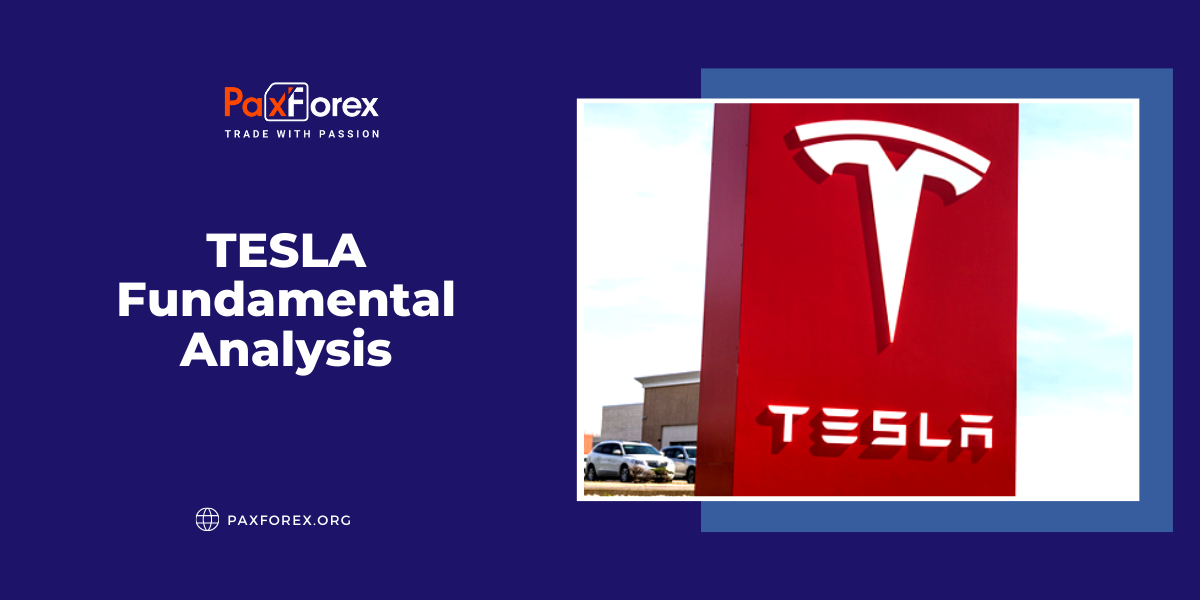
Source: PaxForex Premium Analytics Portal, Fundamental Insight
If you had invested $100,000 in TSLA stock two years ago, today your investment would have grown more than 10 times to $1.2 million. Early Tesla investors undoubtedly enjoy the stock surge. But if you're among those who didn't invest early, you're probably wondering if it's too late to invest in the electric car pioneer.
Let's find out whether it is still profitable to buy the stock.
Founded almost twenty years ago, Tesla made its first annual profit of $721 million in 2020. Last year, the company's profits rose 665% to $5.5 billion. At the same time, the company's revenues rose 71% for the year. The high growth was driven by an 87% increase in car deliveries in 2021.
Most investors and analysts agree that Tesla is likely to continue to increase vehicle deliveries. To that end, the company is opening new plants: deliveries from a plant in Germany began Tuesday, and a plant in Texas is expected to open soon. In short, Tesla is on its way to becoming one of the largest automakers in the world.
And the company has succeeded in distinguishing itself from traditional automakers through high margins.
Ford's high margins in the chart above are due to profits associated with its investment in Rivian. In the fourth quarter, the adjusted EBIT margin was 5.4%. Thus, Tesla's profit margin in the most recent quarter far exceeded that of traditional automakers.
Such high margins can be explained by several factors. The first is high-margin services, including full self-driving features (FSD) and over-the-air software updates, which generate higher margins than traditional car sales. Other factors include high vertical integration, no dealer network, and low marketing costs.
Despite the high growth, with a market capitalization of $1 trillion, value-oriented investors are logically wary of Tesla. But so far, the stock has defied traditional valuation metrics. The big question is, can it continue to do so?
While no one can answer that question definitively, most are inclined to say yes. In addition to high margins and scale, several other factors could support Tesla's valuation going forward. The first of these is the FSD feature.
Tesla already has almost 60,000 vehicles in the FSD beta program. The Insurance Institute for Highway Safety awarded the vision-only version of FSD in some Tesla models an "excellent" rating for collision avoidance and gave it the top Top Safety Pick+ rating.
The company could have significant potential to increase its profits if its FSD feature performs as the company hopes. Although other companies, such as Alphabet with its Waymo and General Motors with its Cruise, are working on autonomous driving, Tesla may have an advantage. Because of the large number of cars in use, it can have far more data to train its program than its rivals. And FSD's in-house developed features would again allow it to take advantage of vertical integration. The company may even offer the feature for a fee to other automakers. But these are just assumptions, and they may not turn out as expected.
While it's hard to imagine what Tesla will do next, its growth depends on innovation. And the company seems to have no shortage of them so far.
Tesla's higher margins lend some credibility to the argument that the company should be valued as a technology stock.
Tesla's high earnings growth rate makes its projected price-to-earnings/growth (PEG) ratio attractive, despite its high price-to-earnings (P/E) ratio.
The PEG ratio compares a stock's P/E to its expected earnings growth. All other things being equal, a stock whose earnings are growing at a higher rate will trade at a higher P/E ratio.
Tesla made $5.5 billion in net income in 2021 after selling nearly 1 million electric cars. As the company's sales grow, its profits should increase proportionately if the company maintains its margins. When that happens, Tesla's current stock valuation will begin to make sense in hindsight. Because the stock price will likely rise even more, making the valuation incomprehensible at that point in the future!
In short, while Tesla stock may not yield as much as it has over the past two years, it looks quite capable of yielding market returns in the coming years. So it's probably not too late to add shares of this leading company to your portfolio.
As long as the price is above the 1000.00 level, follow the recommendations below:
- Time frame: D1
- Recommendation: long position
- Entry point: 1091.00
- Take Profit 1: 1150.00
- Take Profit 2: 1210.00
Alternative scenario:
If the level of 1000.00 is broken-down, follow the recommendations below:
- Time frame: D1
- Recommendation: short position
- Entry point: 1000.00
- Take Profit 1: 890.00
- Take Profit 2: 825.00













